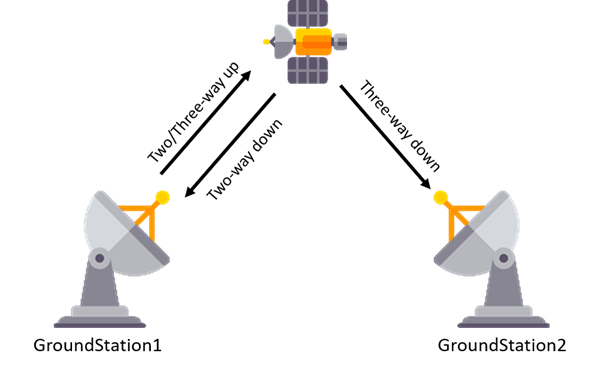The DSN Observation is derived from the Ground Station Observation and represents an observation of a spacecraft from the Deep Space Network (DSN) sites on Earth. The measurement types available for these observations are:
•Range •Range Rate •Azimuth •Elevation •Right Ascension •Declination |
The Measurements for a DSN Observation include an ambiguous range and total phase count, which are resolved to physical units in Range and Range Rate measurements when the observation is processed. Because of the long range nature of DSN observations, angular data is not generally very informative, so Azimuth, Elevation, Right Ascension, and Declination measurements are not used by default. Additionally, DSN Observations cannot be simulated, only processed.
When working with DSN Observations, you have the option to enable Measurement Weighting, as well as the option to include the following corrections:
•Delta Frequency Correction •Ionospheric Correction •Light Time Correction •Tropospheric Correction |
The tropospheric correction calculation relies on the GroundStation.MonthlyRefractivity property, so it is possible to configure different values for the refractivity when simulating the measurements vs. when processing. Similarly, the ionospheric correction calculation relies on the FF_SolarSystem.IonosphereOptions.ScaleFactor property, which can be configured to scale the ionospheric correction values differently for simulating vs. processing. The ground antenna frequencies are also used in computing the ionospheric and tropospheric corrections.
The following tracking data formats supported by FreeFlyer can contain DSN Observations:
The receiving and transmitting antennas for Ground Station Observations and DSN Observations can be configured using the SetObserver(), SetTransmittingAntenna(), and SetReceivingAntenna() methods. When only SetObserver() is used, a single GroundStation is both the transmitter and receiver - this is sometimes called a "2-way" observation. The SetTransmittingAntenna() and SetReceivingAntenna() methods can be used to specify two different GroundAntennas as the transmitter and receiver - this is sometimes called a "3-way" observation. In 2-way observations, the ground antenna transmits a signal to the Spacecraft, which generates a phase coherent downlink signal that is transmitted back to the same ground antenna. In 3-way observations, the Spacecraft is tracked by two different GroundStations. The primary station transmits a signal to the Spacecraft, which returns a signal to both GroundStations, allowing the primary station to behave in 2-way mode while the received frequency at the secondary station can be used for comparison. In this way, the 3-way observation is formed at the second station and based off data from both stations, while the 2-way observation only uses data based off the primary station.

GroundStation1 alone forms a 2-way measurement, GroundStation2 as the receiver yields a 3-way measurement
This can be configured in script as follows:
// Two-way mode option 1 DSNObservation1.SetObserver(GroundStation1.Antenna);
// Two-way mode option 2 DSNObservation1.SetTransmittingAntenna(GroundStation1.Antenna); DSNObservation1.SetReceivingAntenna(GroundStation1.Antenna);
// Three-way mode DSNObservation1.SetTransmittingAntenna(GroundStation1.Antenna); DSNObservation1.SetReceivingAntenna(GroundStation2.Antenna); |
See Also
•DSNObservation Properties and Methods |